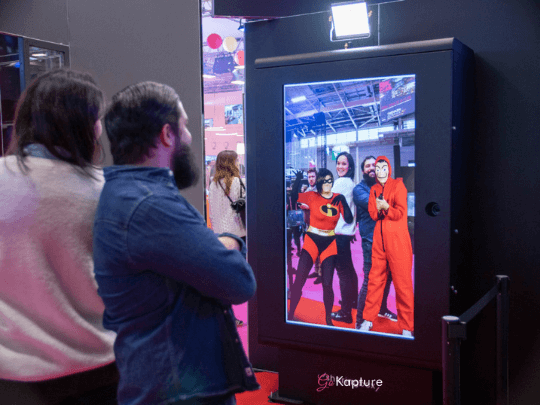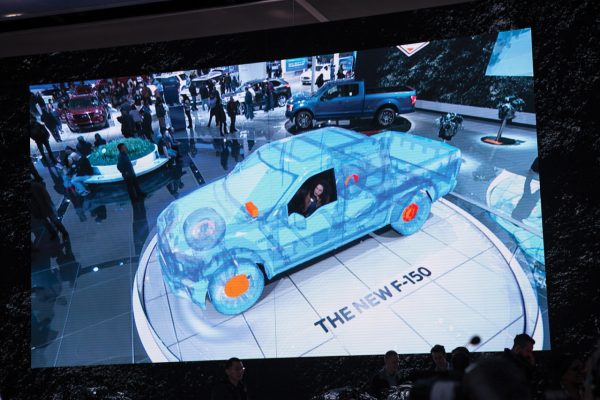50 Great Augmented Reality ideas for events and promotions

1. What is Augmented Reality?
Buckminster Fuller once said, “You never change things by fighting the existing reality. To change something, build a new model that makes the existing model obsolete.” Technology, my friends, is the driving factor to build something that can replace the current reality. With the advancements in technology in today’s era, nothing is impossible. Technological science has been a boon to the human race in all real and virtual aspects. One such technological privilege is Augmented Reality. Let’s use etymology to understand a simplified, literal meaning of the term Augmented Reality. If we go by the dictionary, ‘augmented’ means something greater, larger or more powerfully intense. On the other hand, ‘reality’ is a state of existence. Something is said to be real if it persists in the actual environment and is not a mere imaginative notion. Therefore, ‘augmented reality’ is basically a combination of reality and virtuality. It refers to something that is not completely real, but is derived from the real scenario in such a specialised and expanded version that it seems like the reality itself. Now let’s dive into the scientific approach behind augmented reality. Augmented reality is an experience that is highly interactive. Here, the real-world entities are enhanced via stored information that is perceptual and generated using computers. Augmented reality covers all modes of sensory perceptions- auditory perception, visual system, olfaction, somatosensory and haptic perception.2. History and Origin of Augmented Reality
Augmented Reality is nothing but an enhanced version of the real world entities. It accommodates the use of various inputs that are generated via computers. The inputs can be in the form of images, sounds, graphics, videos etc.
The concept of Augmented Reality first originated in a novel of 1901 by Frank L Baum. It was a mere science-fiction notion and was referred to as a “character marker”. Character marker was a set of glasses that electronically delineated data on people. Unlike the character marker, augmented reality is actually a real concept today.
If we talk about the history of Augmented reality, the concept was discovered much earlier than the coining of the term. In 1957, a cinematographer named Morton Heilig, achieved Augmented reality to some extent. He invented a device that could deliver vibrations, smell, sounds and visuals to the user. He called it the Sensorama. The Sensorama was obviously not controlled by computers, but it is regarded as the first attempt to add additional entities to the real physical world environment.
The term Augmented reality was coined in 1990 by Thomas P Caudell. Louis Rosenberg developed the first fully functional Augmented Reality setup in 1992 at USAF Armstrong’s Research Lab. His setup was a marvellous robotic, complex system named Virtual Fixtures. It was invented in order to indemnify the scarcity of high- speed processing power for 3D graphics.
After 1992, till today, the era of Augmented Reality has witnessed many notable benchmarks such as :
- The development of ARQuake by Bruce Thomas in 2000. ARQuake was an Augmented Reality empowered outdoor mobile game.
- The launch of the designing tool, ARToolkit by Adobe Flash in the year 2009.
- The 2013 announcement of Google Glass, which was an open beta project.
- The launch of HoloLens in 2015 by Microsoft, marking the company’s support towards the growth of Augmented Reality.
3. Difference between Augmented Reality and Virtual Reality
The prime difference between virtual and augmented reality is that augmented reality is actually the real world with computer-generated added enhancements. On the other hand, in the case of virtual reality, the perception of the user is entirely unreal. For example, a general game that involves racing on streets is a virtual reality game whereas an augmented reality game involves movements and motion in real life along with virtual reality. The most suitable example of an Augmented Reality game is Pokemon Go. This trending game engaged the users by giving them real-life tasks.
In a nutshell, virtual reality is something that does not belong to the real world and augmented reality is a combination of real and virtual worlds that presents the real world in a virtually amplified form.
4. Researchers in the field of Augmented Reality
- At Harvard University, Ivan Sutherland developed a VR head-mounted display which was the first of its kind.
- The concept of computer-mediated reality was kept forward by Steve Mann with the use of processors, cameras and display setups in order to enhance dynamic range management. Mann was also an adviser to the augmented reality designing company, Meta.
- Ronald Azuma is another famous researcher in the field of Augmented reality. He is an author as well as a scientist.
- In 2009, Dieter Schmalstieg and Daniel Wagner together invented a system of marker tracking in mobiles and PDAs.
- Jeri Ellsworth is also a famous researcher in this field known for her work in Augmented Reality for the Valve Corporation of America. She carried her research onto her start-up CastAR. However, after the downfall of CastAR, she launched another start-up company named Tilt Five. The company was formed with the motive to create a device to play digital board games.
5. Current and future possibilities with Augmented Reality
We all are aware of the fact that Augmented Reality is here to stay. There are various Augmented Reality possibilities in all the fields at present and in the future and Augmented Reality examples in daily life. Let us take some of these fields into consideration.
Augmented Reality in Education Section
To regulate a standard curriculum of studies, Augmented reality is highly helpful in the current and future education. The real-life surroundings of a student can be coincided with computer generated text, videos, audios and graphics. The future generations will study with textbooks with in-built flashcards embedded with markers and QR codes which would be scanned easily and used via an Augmented reality device. Students can get supplements in the form of multimedia.
With the evolution of Augmented reality, young generations can interact with softwares like Google Glass, Construct3D, Chemistry Augmented Reality app, HP Revealts and become active learners. Also, Augmented Reality Event Management has become a new and totally different career option with a lot of scope in the upcoming days.
Augmented Reality in URBAN PLANNING
Nowadays, Augmented reality systems have even crossed the building barriers and are now used as tools to collaborate with urban planning and designing. In the near future, urban planners would prefer Augmented reality tools more than the digital and hand-drawn blueprints. Augmented reality setup can be used to design three-dimensional maps and blueprints of buildings in a table-top view with the smallest of details.
With the help of outdoor augmented reality, ideas and designs can be superimposed onto real-world buildings in order to re-define and re-design the old ones. It will be much easier for urban planners to choose the perfect colour for their building or the perfect design for a mansion, discarding the old, traditional methods of 2D desktop maps and 3D models of the building.
Augmented Reality in MARKETING
Marketing is among the fields that have been immensely affected by the growth of augmented reality, for good. Sales and marketing customers are always desiring new experiences and amusement but at the same time, convenience. Augmented reality has made it facile for the brands and companies to please their customers with the click of a button. There are numerous Augmented reality events and Augmented reality projects that are running online. Augmented Reality is a two-in-one way to drive sales and enhance your brand value. Brands are wisely using Augmented reality in events allowing their customers to do all sorts of quirky yet fun activities.
In order to increase engagement and advertisement, brands are even giving an opportunity to their consumers to try the products before buying them. Isn’t it amazing that you can test drive a brand new car with a tap on the mobile phone, without even going out on the road!
Augmented Reality in Visual Art
Augmented reality can be a boon in the aspects of visual art. Visitors can view the beautiful artworks of a museum in a multidimensional manner via their mobile phone screens. Augmented reality can be used to trigger artistic experiences and multidimensional interpretations of the real world. For example, the Museum of Modern Art in New York has created an Augmented reality exhibit that can be accessed with an application on the users’ smartphones. The app is called MoMAR Gallery and it can be downloaded by the users if they wish to take a look at the paintings of the Museum in a totally different way. Some features of the application include visibility of hidden aspects, interaction with artwork, information about the painting etc.
Augmented Reality in Events and Promotions
Today, companies and brands are using augmented reality to their aid in all ways. Augmented Reality is used to generate a real-life environment for all the viewers in an online or offline promotional event. Augmented Reality event examples are high on user engagement and interaction. Some brands have also started Augmented Reality live event promotions and advertisements.The business industry has begun to mould with the advancements in technology. Augmented Reality has changed their way of interaction, engagement, attendance, marketing and promotions. Consumer experiences of an event that involves Augmented Reality are proved to be 70% more memorable.
50 Great Augmented Reality ideas for events and promotions
Brands and companies have been using Augmented Reality for nearly a decade now. But, after the advent of the pandemic, the entire business protocol shifted online. All the huge gatherings and physical conferences turned into video calls and Google Meet meetings. Since then, AR based events and promotions have achieved a major boost. According to Forbes, in 2020, the annual growth of AR VR purchases increased nearly 50% in comparison to 2019. The year 2020 witnessed 32% of the consumers who switched to Augmented Reality for shopping, summing up a total turnover of more than 12 billion US dollars!
Listed below are Augmented Reality examples 2020, various Augmented Reality events 2021, AR VR events 2022 and other examples of how different companies used Augmented Reality for promotional events in recent years.
1. Bosch- Augmented Reality Photo booth
The famous multinational company, Bosch reached out to us at GoKapture to engage their employees and attendees via an Augmented reality Photo booth. The users could change backgrounds and click pictures with mere hand gestures.
Book Augmented Reality Photo Booth with GoKapture, now!
2. AirCards- Interstellar Portal
3. Kinder- Portal experience
4. Samsung- virtual event
5. Jackson Hogg- Recruiting Event
6. Boot Barn- Printed Commercial
7. Hewlett Packard- Enterprise Product Launch
8.The Motley Fool- Choose Your Retirement
9. Alnwick Garden- AR Brochure
Alnwick Garden prepared an AR brochure to display their offerings to the visitors. The brochure shows butterflies flitting and waterfall cascading, it feels more than real.
10. Vodafone- Unwrap lunch on us
11. Dell Technologies- Live Event
12. Bon V!V- OOH Campaign
Bon V!V took their extraordinary use of AR to the streets. As a part of their marketing campaign, they transformed the city walls into a virtual vending machine that distributed their yummy Spiked Seltzer.
13. Nutanix- Virtual Event Space
14. Pot Noodle- Careers Fair
15. Google Pixel- Star Wars stickers
16. Intel- Innovative Press Conference at CES 2017
17. Ford- Virtual reality peek




